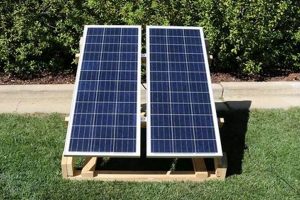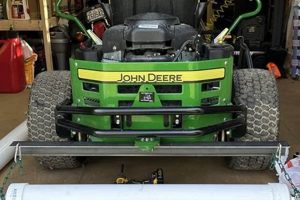A comprehensive solution designed for vehicle owners, provides the means to apply a protective layer to a vehicle’s paintwork outside of professional detailing services. These packages typically include a ceramic coating solution, application tools like microfiber cloths and applicators, and surface preparation products such as cleaning solutions. The result is a durable, hydrophobic barrier against environmental contaminants.
The appeal of this automotive care approach lies in its cost-effectiveness and convenience compared to professional applications. It allows individuals to enhance their vehicle’s shine, protect against UV rays, chemical stains, and minor scratches, and simplify the cleaning process. Historically, such advanced coatings were exclusive to professional detailers, but advancements in chemistry and packaging have made them accessible to the general public.
Understanding the proper application techniques, surface preparation methods, and the long-term maintenance is critical for achieving optimal results. The following sections will delve into the specifics of surface preparation, the application process itself, post-application care, and factors influencing the final outcome of this protective measure.
DIY Ceramic Coating Application Tips
Achieving optimal results from a DIY ceramic coating application requires meticulous attention to detail and adherence to best practices. The following tips aim to enhance the longevity and effectiveness of the applied coating.
Tip 1: Prioritize Surface Preparation: Thoroughly decontaminate the vehicle’s paint. This includes washing, clay bar treatment, and potentially polishing to remove imperfections. A clean, smooth surface ensures optimal bonding of the coating.
Tip 2: Work in a Controlled Environment: Apply the coating in a well-lit, temperature-controlled environment away from direct sunlight and excessive humidity. This minimizes the risk of premature curing or streaking.
Tip 3: Apply Thin, Even Coats: Over-application of the product does not enhance protection and can lead to unevenness. Use the applicator provided in the kit and apply the coating in thin, overlapping layers.
Tip 4: Adhere to Curing Times: Strictly follow the manufacturers recommended curing times between coats and before exposing the vehicle to the elements. This allows the coating to fully harden and bond to the surface.
Tip 5: Use Proper Lighting: Employ adequate lighting to inspect the coated surface for high spots or missed areas immediately after application. Address any imperfections promptly.
Tip 6: Invest in Quality Microfiber Towels: Use clean, lint-free microfiber towels specifically designed for automotive detailing to buff off excess coating. Avoid using the same towel for multiple applications.
Tip 7: Consider a Panel-by-Panel Approach: Work on small sections of the vehicle at a time to maintain control over the application process and ensure consistent coverage.
By following these guidelines, individuals can maximize the protective and aesthetic benefits of a ceramic coating applied at home. These practices promote a uniform, durable finish that enhances the vehicle’s appearance and safeguards against environmental hazards.
These tips serve as a foundation for a successful application. The subsequent sections will explore specific product recommendations and long-term maintenance strategies to further optimize the effectiveness of the DIY ceramic coating process.
1. Surface Preparation
Surface preparation is a critical and foundational stage in the successful application of a DIY ceramic coating. It directly impacts the coating’s ability to bond correctly with the vehicle’s paint, influencing its durability, longevity, and overall performance.
- Decontamination and Cleaning
This initial step involves removing all existing contaminants from the vehicle’s surface. This includes dirt, road grime, tar, and any previously applied waxes or sealants. A thorough wash with a pH-neutral car soap followed by the use of a clay bar is typically required. Failure to adequately decontaminate the surface will prevent the ceramic coating from properly adhering, leading to premature failure and diminished protection. Imagine applying a protective film to a dirty screen; the film will not adhere smoothly or effectively.
- Paint Correction (Polishing)
Polishing is the process of removing minor imperfections in the paint, such as swirl marks, scratches, and oxidation. These imperfections can not only detract from the final appearance of the coated vehicle but also create an uneven surface that inhibits optimal bonding. Using a machine polisher with appropriate pads and compounds refines the paint surface, creating a smooth, level base for the ceramic coating to adhere to. The polished surface maximizes the coating’s reflective properties, enhancing the vehicle’s gloss and depth.
- Degreasing and IPA Wipe-Down
Even after polishing, residual oils and polishing compounds can remain on the paint surface. These residues can interfere with the ceramic coating’s ability to bond effectively. Degreasing the surface with a dedicated degreaser or an Isopropyl Alcohol (IPA) wipe-down removes these oils, ensuring a clean and receptive surface for the coating. This step is often overlooked but is crucial for maximizing the coating’s adhesion and longevity.
- Environmental Control
Surface preparation is not only about the products used but also about the environment in which the preparation is carried out. A controlled environment, such as a garage or covered workspace, is essential to prevent the reintroduction of contaminants during the preparation process. Direct sunlight and extreme temperatures can also negatively affect the application and bonding of the ceramic coating. Maintaining a stable and clean environment is an integral part of effective surface preparation.
In summary, proper surface preparation is the bedrock of a successful DIY ceramic coating application. A meticulous approach to cleaning, polishing, degreasing, and environmental control ensures that the ceramic coating bonds effectively, providing long-lasting protection and enhancing the vehicle’s appearance. Skimping on this stage often results in compromised performance and reduced longevity, negating the benefits of the ceramic coating itself.
2. Application Technique
The application technique is intrinsically linked to the efficacy of a DIY ceramic coating kit. The quality of the product itself is rendered inconsequential if the application is performed incorrectly. A proper application ensures the ceramic molecules bond uniformly with the vehicle’s paint, creating the intended protective layer. Conversely, improper tec
hnique leads to streaking, uneven coverage, and ultimately, a diminished protective barrier. For instance, applying too much coating at once results in difficulties during the leveling process, potentially causing visible imperfections. The application technique is therefore not merely a step in the process, but a critical determinant of the final outcome.
Specific application steps, such as priming the applicator, applying the coating in a crosshatch pattern, and precisely timing the leveling process, directly impact the coating’s performance. Many kits provide detailed instructions outlining these steps, emphasizing the importance of strict adherence. Deviations from these recommended practices often result in suboptimal results. Consider the scenario where the leveling process is initiated prematurely: the coating may not have adequately bonded, leading to its removal during the wiping phase. This demonstrates the direct cause-and-effect relationship between the application technique and the coating’s integrity.
In conclusion, the application technique represents a pivotal aspect of the DIY ceramic coating process. Its mastery is essential for realizing the intended benefits of the coating, including enhanced gloss, hydrophobic properties, and protection against environmental contaminants. Neglecting the nuances of the application technique renders the investment in a DIY ceramic coating kit largely ineffective. Therefore, meticulous attention to detail and a thorough understanding of the recommended application procedures are indispensable for achieving a professional-grade finish.
3. Curing Time
Curing time represents a critical phase in the application of a DIY ceramic coating kit, directly influencing the coating’s final hardness, durability, and protective capabilities. This period allows the ceramic molecules to fully cross-link and bond to the prepared surface, forming a robust, chemically resistant barrier. Insufficient curing time compromises the coating’s structural integrity, rendering it susceptible to premature degradation and diminished performance. For example, if a vehicle is exposed to water or chemicals before the coating has fully cured, the bonding process can be disrupted, resulting in water spots, reduced gloss, and a shorter lifespan of the protective layer.
The duration of the curing time varies depending on the specific formulation of the ceramic coating, environmental conditions such as temperature and humidity, and the thickness of the applied layer. Manufacturers typically provide detailed instructions outlining the recommended curing time, which should be strictly adhered to. During this period, the vehicle should be kept in a clean, dry, and temperature-controlled environment to facilitate optimal cross-linking. In practical application, consider a scenario where two identical vehicles are coated with the same DIY kit; one is allowed to cure for the recommended time in a garage, while the other is left outside. The vehicle cured indoors will exhibit superior hardness, gloss retention, and chemical resistance compared to the one exposed to the elements during the curing process.
In summary, curing time is not merely a waiting period but an active phase in the ceramic coating process. It directly dictates the final performance and longevity of the protective layer. Understanding and adhering to the manufacturer’s recommended curing time is essential for achieving optimal results with a DIY ceramic coating kit. Any deviation from the specified curing parameters can significantly compromise the coating’s protective properties and overall effectiveness. Therefore, patience and attention to detail during this phase are paramount for realizing the full potential of the DIY ceramic coating investment.
4. Environmental Conditions
Environmental conditions exert a significant influence on the application and performance of a DIY ceramic coating kit. Temperature, humidity, and airborne particulate matter directly impact the bonding process, curing time, and ultimate durability of the coating. The following facets detail these environmental factors and their specific effects on the DIY ceramic coating application.
- Temperature
Temperature affects the viscosity and evaporation rate of the ceramic coating. High temperatures accelerate the drying process, potentially leading to streaking or uneven application if the coating cures too rapidly. Conversely, low temperatures can slow the curing process, prolonging the time required for the coating to fully harden and bond to the surface. The ideal temperature range for application typically falls between 60F (15C) and 80F (27C). Applying the coating outside of this range can compromise its effectiveness and longevity. For example, applying a ceramic coating in direct sunlight on a hot summer day will likely result in premature curing and a less durable finish.
- Humidity
Humidity levels impact the curing process by affecting the rate at which the solvents in the ceramic coating evaporate. High humidity can slow down evaporation, leading to a longer curing time and potentially interfering with the bonding process. Excessive moisture can also create a hazy or cloudy finish. Low humidity, on the other hand, can cause the coating to dry too quickly, resulting in streaking or uneven coverage. The optimal humidity range for application is typically between 40% and 60%. Applying the coating in a damp or humid environment can compromise its adhesion and protective properties.
- Airborne Particulate Matter
Dust, pollen, and other airborne contaminants can settle on the vehicle’s surface during the application and curing process, embedding themselves in the coating and creating imperfections. These contaminants can detract from the coating’s gloss and smoothness, and can also compromise its protective properties by creating weak points in the barrier. Applying the coating in a clean, enclosed environment, such as a garage or detailing bay, minimizes the risk of contamination. Thoroughly cleaning and decontaminating the vehicle’s surface before application is also essential to remove existing particulate matter. Failure to control airborne contaminants can lead to a less-than-optimal finish and reduced coating lifespan.
These environmental considerations underscore the importance of careful planning and execution when using a DIY ceramic coating kit. Controlling these factors is important for the long-term aesthetic and protective benefits the coatings are intended to deliver.
5. Product Quality
The product quality of a DIY ceramic coating kit directly dictates the outcome of the application, influencing its longevity, protective capabilities, and aesthetic enhancement. Selecting a kit with superior components is essential to realize the intended benefits and avoid potential damage to the vehicle’s paintwork.
- Ceramic Coating Formulation
The composition of the ceramic coating itself is paramount. High-quality formulations utilize advanced polymers and a higher concentration of silicon dioxide (SiO2), resulting in a more durable and chemically resistant layer. Inferior formulations may contain diluted concentrations
or less effective polymers, leading to reduced protection and a shorter lifespan. An example is a coating with high SiO2 content providing superior resistance against acid rain compared to a low-concentration alternative. The selected formulation must strike a balance between ease of application and long-term performance. - Applicator Materials
The quality of applicators included in the kit significantly impacts the uniformity and effectiveness of the coating application. High-density foam applicators minimize product absorption and facilitate even distribution across the surface. Microfiber cloths designed for coating application are lint-free and non-abrasive, reducing the risk of scratching or marring the paint. Low-quality applicators can introduce imperfections or uneven coating thickness, compromising the finish. Using a substandard applicator can lead to streaks, blotches, or premature failure of the coating.
- Surface Preparation Products
Many kits include surface preparation products such as cleaning solutions and degreasers. These products must be effective at removing contaminants without damaging the vehicle’s paint. High-quality preparation products ensure proper bonding of the ceramic coating by removing residual oils, waxes, and other impurities. Ineffective cleaning solutions can leave behind residues that interfere with the coating’s adhesion, leading to premature peeling or reduced gloss. The formulation of these pre-application treatments is as vital as the coating itself.
- Clarity of Instructions and Support
A high-quality DIY ceramic coating kit includes clear, concise instructions that guide the user through each step of the application process. Comprehensive instructions minimize the risk of errors and ensure that the coating is applied correctly. Access to customer support, such as online tutorials or phone assistance, further enhances the user experience and provides valuable guidance in case of difficulties. Lack of clear instructions or support can lead to improper application, resulting in suboptimal results and potential damage to the vehicle’s paintwork.
The investment in a DIY ceramic coating kit should prioritize product quality to ensure a long-lasting, protective, and aesthetically pleasing finish. Compromising on quality can lead to premature failure, reduced protection, and potentially irreversible damage to the vehicle’s paint. Opting for reputable brands with established track records is often a wise choice to mitigate these risks and achieve the desired results.
6. Maintenance Regimen
The longevity and performance of a DIY ceramic coating are intrinsically linked to the establishment and consistent execution of a structured maintenance regimen. While the initial application provides a layer of protection, its sustained effectiveness hinges upon proactive care. Environmental contaminants, road salts, and improper washing techniques can gradually degrade the coating’s hydrophobic properties and overall integrity, thereby diminishing its protective capacity. A well-defined maintenance protocol mitigates these effects, preserving the coating’s intended performance characteristics. For instance, regular washing with pH-neutral soaps prevents the build-up of mineral deposits and grime, which can otherwise obscure the coating’s reflective properties and reduce its water-repelling capabilities. Without such a protocol, the investment in a DIY ceramic coating kit yields only short-term benefits.
A comprehensive maintenance regimen extends beyond simple washing. Periodic decontamination using specialized detailing sprays or clay bars removes embedded contaminants that washing alone cannot eliminate. The application of coating-specific boosters or toppers, as recommended by the manufacturer, replenishes the hydrophobic properties and enhances the coating’s self-cleaning abilities. Furthermore, avoiding abrasive cleaning tools and harsh chemicals prevents scratching or premature wear of the coating. An example of this is using a microfiber wash mitt instead of a sponge to avoid scratching the ceramic. Each element of the maintenance schedule contributes to the coating’s continued performance and visual appeal, ensuring that the vehicle remains protected and aesthetically pleasing.
In summary, the maintenance regimen is not an ancillary consideration but an integral component of the DIY ceramic coating process. Its implementation directly impacts the coating’s durability, protective capabilities, and aesthetic longevity. Neglecting maintenance renders the initial application a temporary measure, ultimately undermining the benefits derived from the ceramic coating kit. Establishing and diligently adhering to a structured maintenance program ensures that the investment in DIY ceramic coating yields long-term protection and sustained aesthetic enhancement for the vehicle.
Frequently Asked Questions
This section addresses common inquiries and misconceptions surrounding the application and maintenance of DIY ceramic coating kits, providing clear and concise information for optimal results.
Question 1: What is the expected lifespan of a DIY ceramic coating?
The lifespan varies depending on the product quality, application technique, environmental conditions, and maintenance regimen. Generally, a properly applied and maintained coating can last between 12 to 36 months.
Question 2: Can a DIY ceramic coating correct existing paint imperfections?
No. A ceramic coating is a protective layer and will not correct existing paint imperfections such as swirl marks or scratches. Paint correction, such as polishing, must be performed before applying the coating.
Question 3: Is specialized equipment required for DIY ceramic coating application?
While professional equipment is not strictly necessary, meticulous surface preparation is. A polisher will greatly improve the final result. Basic equipment, such as microfiber cloths and applicators, is typically included in the kit.
Question 4: How does a DIY ceramic coating compare to professional application?
Professional applications typically offer greater longevity and potentially superior results due to specialized equipment and expertise. However, a properly executed DIY application can provide significant protection and aesthetic enhancement at a lower cost.
Question 5: What happens if the DIY ceramic coating is applied incorrectly?
Incorrect application can result in streaking, uneven coverage, or reduced lifespan. In some cases, it may require polishing the vehicle to remove the improperly applied coating and re-application.
Question 6: What maintenance products are recommended for vehicles with a DIY ceramic coating?
pH-neutral car soaps are recommended for washing. Avoid abrasive cleaners and harsh chemicals. Regular decontamination with a clay bar or detailing spray is also beneficial.
Proper surface preparation and maintenance are important. Quality should also be considered in order to protect surface.
The next section will delve into troubleshooting common problems encountered during the DIY ceramic coating process.
Conclusion
The preceding analysis has illuminated the multifaceted nature of DIY ceramic coating kits. Successful implementation demands rigorous adherence to best practices in surface preparation, meticulous application techniques, careful attention to curing times and environmental
conditions, astute selection of product quality, and a committed maintenance regimen. Each element contributes to the coating’s performance and longevity, shaping the final result. Neglecting any single aspect can compromise the coating’s effectiveness, diminishing its protective capabilities and aesthetic enhancement.
DIY ceramic coating kits offer vehicle owners a viable pathway to achieving professional-grade protection and aesthetic improvements at a reduced cost. However, this endeavor requires diligence, precision, and a comprehensive understanding of the underlying principles. The information presented serves as a foundation for informed decision-making, empowering individuals to navigate the complexities of DIY ceramic coating application with confidence. It is incumbent upon the user to critically assess each factor and execute the process with meticulous care to realize the full potential of this protective automotive treatment.


![Easy DIY Gazebo Kit Assembly: [Your City/Style] The DIY Hub: Creative Crafts, Repairs & Life Hacks Easy DIY Gazebo Kit Assembly: [Your City/Style] | The DIY Hub: Creative Crafts, Repairs & Life Hacks](https://craftingdiycenter.com/wp-content/uploads/2025/07/th-4949-300x200.jpg)




